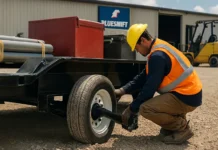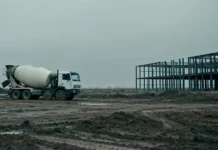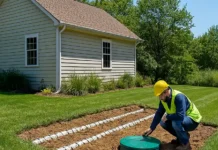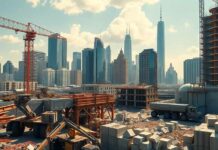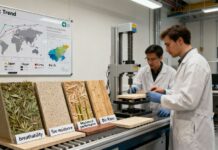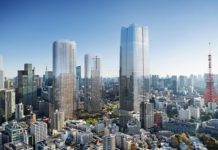Fire-Resistant Composite Façades: What Architects Should Know
Fire-resistant composite façades are becoming increasingly important in today’s world of contemporary design. These solutions, which combine design freedom, safety, and structural efficiency, revolutionised building aesthetics and performance. However, when architects innovate and question the regulations, fire safety remains front of mind. Whether fire-resistant composite façades can withstand extreme conditions is not merely a technical question but an important design determinant that can be the difference between life and death, as well as international safety codes compliance.
Composite façade systems like Aluminum Composite Panels (ACPs) and Glass Fiber Reinforced Polymers (GFRP) are quite renowned for uniting form with function. Architecturally, the materials are largely preferred due to their lightness, moldability, and efficiency in energy saving. However, the spotlight has also been highlighted on their resistance to fire, especially in light of worldwide top-level façade fire incidents where the importance of stringent fire safety measures is pointed out.
The Vital Role of Fire Resistance in Façade Systems
Fire-resistant composite façades are created to resist fire exposure without fueling the spread of flames. This is important because façades are the initial interface between the external environment and the building interior. An improperly fire-resistant façade will facilitate the spread of fire, collapse due to thermal stress, and emit harmful fumes, thereby putting lives and property at risk.
To counter this, the fire resistance of composite materials has made incredible progress. Materials like fire-retardant cores and intumescent coatings have revolutionized composites like ACPs and GFRP to become more safe options. For instance, ACPs with mineral-filled core are more fire-resistant than the conventional polyethylene core. Likewise, GFRP can be strengthened with chemical additives that are fire-resistant, making them ideal for use in high-risk areas.
The performance of fire-resistant composite façades is also established by strict testing on the basis of international safety standards. In Europe, methods like EN 13501-1 and in the US, NFPA 285 put things into groups based on how easily they catch fire, how much smoke they give off, and how quickly they spread. Architects need these kinds of tests to make sure they’re following the rules and making sure the buildings they plan are safe.
Innovations in Fire-Resistant Composite Materials
The development of fire-resistant composite façades has been driven by advances in material science. Contemporary composites are now designed to reduce fire hazards without sacrificing their structural and aesthetic advantages. Aluminum Composite Panels, for example, have been developed to incorporate non-combustible mineral cores, which greatly improve their fire resistance while maintaining their lightness and modularity.
Similarly, GFRP is also a revolutionary material in fire-resistant façade architecture. With its capability to have high tensile strength and moldability, GFRP is being used more and more for producing intricate, freeform geometries. Fire-resistant versions of GFRP are designed with advanced resins and orientations of fibers in order to meet rigorous fire codes. These technologies are not only technological breakthroughs but are crucial in helping façades live up to current performance and safety standards.
Strategies for Architectural Fire Safety
Incorporating fire-resistant composite façades goes beyond material selection. Architects have a key role in employing design strategies that enhance fire safety. This involves integrating fire barriers between panels to prevent flame spread, using non-combustible insulation layers, and compartmentalizing façades into sections that can contain potential fire outbreaks.
In addition, the behavior of composite façades under thermal stress should be accounted for by architects. Such materials as GFRP, characterized by their anisotropic nature, can efficiently withstand load paths and the dynamic forces when exposed to fire. Being able to hold up under stress makes GFRP a sought-after material for high-performance façades.
Sustainability Meets Fire Resistance
The demand for energy-efficient building products has crossed over with fire safety requirements, and fire-resistant composite façades are at this crossing point. The systems comply with sustainable design aspects by providing light construction, lower maintenance, and longer lifetimes. Recyclable composites and non-toxic fire retardants are also decreasing the environmental footprint of these products.
Lifecycle studies indicate that the use of fire-resistant composite façades results in massive savings of material waste during production and reduced energy usage during transportation and installation. To architects dedicated to green building accreditation, like LEED or BREEAM, these façades assist in achieving sustainability without sacrificing fire performance.
Case Studies: Real-World Applications
The extreme significance of fire-resistant composite façades is exemplified in many international projects. In Singapore’s Marina Bay Sands Hotel, fire-resistant ACPs were selected to safeguard while attaining the legendary curved profile. In the region with a high incidence of fires in the Middle East, composite façades with new-generation fire retardant capabilities have been extensively utilized in skyscrapers and commercial centers.
These developments reflect how fire-resistant composite façades deliver a double benefit—facilitating new designs while ensuring safety is in no way compromised.
Significance of Fire Safety Standards
Abiding by fire safety regulations is vital for successful implementation of fire-resistant composite façades. Architects have to rigorously test whether façade materials comply with regulations like ASTM E119 or EN 13501-1. It is not merely a juridical requirement but a moral imperative to safeguard lives and communities in the event of an unexpected fire incident.
Architects’ Responsibility in Façade Safety
For architects, fire-resistant composite façades are both a creative challenge and professional responsibility. Although such materials provide the versatility to create stunning, innovative designs, architects must also incorporate safety into every aspect of the project, from the selection of materials to installation.
Close working relations with fire engineers, manufacturers, and regulatory agencies are crucial to ensuring that the latest developments in fire-resistant composite technology are at their disposal. In addition, applying computer-aided design technologies like BIM allows simulating actual fire conditions, thus enhancing planning and risk management.
Conclusion: Pioneering Fire Safety in Architecture
The development of fire-resistant composite façades is a landmark step towards producing safer, greener, and more aesthetically beautiful buildings. Such systems are a crossroads between innovation and accountability that allow architects to design buildings that are innovative and also meet the stringiest safety standards.
By incorporating fire resistance into the DNA of composite façades, architects not only save lives, but also ensure a future in which building design may be both ambitious and safe. As the world approaches the pinnacle of architectural innovation, fire-resistant composite façades are poised to be a cornerstone of that vision—a future in which beauty, safety, and sustainability coexist harmoniously.



